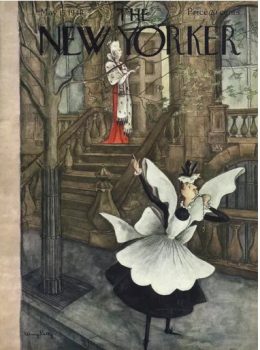A to Z Reviews: “Signs and Symbols,” by Vladimir Nabokov
 Vladimir Nabokov originally published “Signs and Symbols” in the New Yorker on May 15, 1948, although the editor, Katharine White, switched the order of the title to “Symbols and Signs.” Nabakov changed it back for subsequent publication, as well as reverting other changes White had made to the story. In 2020, Ann and Jeff Vandermeer included the story in their massive anthology The Big Book of Modern Fantasy.
Vladimir Nabokov originally published “Signs and Symbols” in the New Yorker on May 15, 1948, although the editor, Katharine White, switched the order of the title to “Symbols and Signs.” Nabakov changed it back for subsequent publication, as well as reverting other changes White had made to the story. In 2020, Ann and Jeff Vandermeer included the story in their massive anthology The Big Book of Modern Fantasy.
A couple is trying to do their parental duty by visiting their son for his birthday. Despite loving their son, the fact that he suffers from referential mania and lives in an asylum makes them vaguely uncomfortable in visiting him as they are never quite sure what to expect, whether he’s having a good or bad day, and how well he will interact with the real world.
 The focus of the story is on the couple and their lives, Nabokov providing various details about their health, financial situation, and the fact that they are Jewish immigrants who lost a good deal of their family in the Holocaust. There is nothing easy about their lives, made more difficult by their son’s mental condition. Their almost palpable relief when they are turned away by the nurse because a visit by his parents might disturb him is both sad and understandable.
The focus of the story is on the couple and their lives, Nabokov providing various details about their health, financial situation, and the fact that they are Jewish immigrants who lost a good deal of their family in the Holocaust. There is nothing easy about their lives, made more difficult by their son’s mental condition. Their almost palpable relief when they are turned away by the nurse because a visit by his parents might disturb him is both sad and understandable.
The parents return to their quotidian life, traveling home on the subway and buying fish for dinner. The story ends with the father reconsidering their decision to keep their son in an asylum and a series of calls that may be misdialed calls or may be connected to their son’s mental condition.
“Signs and Symbols” is a layered story, with at least three narratives talking place within its relatively short length. The first is the story of the parents’ attempted visit to their son. The second is the implied story of their son’s insanity and the way he sees the world. Nabokov provides some clues in his descriptions about how the son may respond to the world around him and his parents, indicating the divergence from reality without providing an explanation for the break from reality. The third story is hidden underneath and is hinted at by the phone calls at the end of the story.
Because of where Nabokov ends the story, it is difficult for the reader to determine exactly what the importance of the phone calls looking for “Charlie” are. Although the woman explains that the girl is dialing the letter “o” (6) instead of the number 0, an equally plausible reading of the situation, given her comment that the first call frightened her, is that the call was for her unnamed son, or had something to do with him in some way. The strength of the story to stick with the reader is this ambiguous ending.
The very ambiguity that makes the story memorable also makes the story somewhat unsatisfactory. Nabokov clearly did not want to provide his readers with an easy or succinct explanation for what is happening to his characters. His decision to layer the story and not provide an ending, however, also means that the story is open to numerous interpretations, any, or all, of which can be correct.
 Steven H Silver is a twenty-time Hugo Award nominee and was the publisher of the Hugo-nominated fanzine Argentus as well as the editor and publisher of ISFiC Press for eight years. He has also edited books for DAW, NESFA Press, and ZNB. His most recent anthology is Alternate Peace and his novel After Hastings was published in 2020. Steven has chaired the first Midwest Construction, Windycon three times, and the SFWA Nebula Conference six times. He was programming chair for Chicon 2000 and Vice Chair of Chicon 7.
Steven H Silver is a twenty-time Hugo Award nominee and was the publisher of the Hugo-nominated fanzine Argentus as well as the editor and publisher of ISFiC Press for eight years. He has also edited books for DAW, NESFA Press, and ZNB. His most recent anthology is Alternate Peace and his novel After Hastings was published in 2020. Steven has chaired the first Midwest Construction, Windycon three times, and the SFWA Nebula Conference six times. He was programming chair for Chicon 2000 and Vice Chair of Chicon 7.